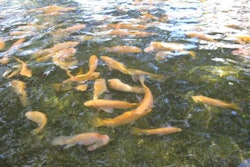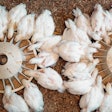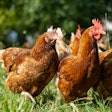
Soybean meal and dried distiller’s grains with solubles (DDGS) remain the primary source of protein for broilers in the U.S. In fact, soybean meal is the No. 1 source of protein for broilers worldwide, but its use is supplemented by locally available secondary sources such as DDGS as mentioned above, rapeseed meal (western Europe) and sunflower meal (eastern Europe), to mention only the most prevalent ones.
There are minor, local sources of protein that can offer the benefits of volume and low prices. When such opportunity arises, broiler producers are enticed to use these alternative, protein-rich ingredients, but results are often disappointing. The main reason is not as much quality, but rather lack of understanding of the limitations posed by each ingredient. These limitations arise from the concentration, which can be quite variable, of certain anti-nutritional factors that cause an almost toxic effect in the bird’s metabolism. Knowing these factors and their concentration can lead to very successful feed formulations using alternative protein sources and to very profitable production outcome.
1. Palm kernel meal
The rapid growth of palm oil production in Asia, Australia, South America and Africa has led to tremendous quantities of palm kernel meal being available for all types of livestock. Not a protein-rich ingredient (less than 18 percent crude protein), palm kernel meal remains an interesting ingredient because it can contribute to significant cost savings. It is poor in lysine and methionine, with average digestibility values, but it contains sufficient energy to constitute a good part of the total dietary protein fraction. It is also relatively high in crude fiber (up to 20 percent). In many aspects, palm kernel meal can be compared to corn gluten feed. It is speculated that any adverse effects of palm kernel meal observed in broilers is due to its grittiness and overall physical quality aspects and not due to its nutrient profile. As such, high quality palm kernel meal can be used relatively freely, within constrains imposed by its limited nutrient profile, in broiler diets.
2. Corn gluten meal
There is nothing really wrong with corn gluten meal, which is a by-product of the starch extraction process from corn kernels. It contains about 60 pecent crude protein, with digestibility values being comparable to that of corn. It also contains the majority of pigments from the kernel, and it leads to heavy pigmentation of the broiler skin — which can be a desirable or undesirable carcass trait according to market circumstances.
Read more: Understanding specialty soy proteins in a global market
Its inclusion rate is limited by its amino acid profile (very low in lysine), and its high cost that arises from its frequent use as a source of natural pigments in layer diets. In general, it is not advisable to use other corn-derived protein-rich ingredients in diets based on DDGS as this will increase the difficulty in balancing the diet’s amino acid profile. Finally, corn gluten meal should not be confused with corn gluten feed (20 percent crude protein) or the mix of the two usually marketed as corn gluten (40 percent crude protein).
3. Cottonseed meal
A by-product of the extraction of oil from cotton seeds, this protein source is not often available for broiler feed due to competition from ruminant feeds — something that increases its price. Cottonseed meal contains about 40 percent crude protein, of moderate digestibility, whereas the major anti-nutritional factor is gossypol. Broilers can withstand much higher levels of gossypol compared with layers, but the usually high fiber concentration (15 percent) in cottonseed meal will pose an upper limit in formulation. In regards to gossypol, it is possible to reduce the negative effects by neutralizing it through the addition of certain iron salts. Low- or no-gossypol cultivars are also available yielding meals that are tolerated well by broilers. A gradual introduction into feed formulas is recommended.
4. Peanut meal
Peanut butter or oil is the primary reason why peanut meal exists in great quantities in areas that produce peanuts for human consumption. Peanut meal is considered an appetizing ingredient for monogastrics, perhaps due to its residual oil concentration (about 1 percent). Peanut meal contains about 50 percent crude protein of good digestibility value, and a few anti-nutritional factors (mainly trypsin inhibitor activity) similar to soybeans, most of which are neutralized during the extraction process.
As peanuts grow in the soil and usually in warm and moist climates, the amount of mycotoxins can be relatively high.
The main limitations in the use of peanut meal are the level of fiber that is a result of the manufacturing process and the presence of mycotoxins (mainly aflatoxins). As peanuts grow in the soil, and usually in warm, moist climates, the amount of mycotoxins can be relatively high. The only solution remains quality control at the receiving factory excluding batches with a high degree of contamination. Ammoniation and aflatoxin binders in the feed are the second-best alternative. Otherwise, peanut meal can be used relatively freely in diets for broilers, even in the first diet post-hatch.
5. Guar gum meal
Guar is a legume, widely cultivated in India and Pakistan, and also in certain parts of the U.S. and other countries. Its main use is for the production of mannogalactan gum, a binder for the paper and pigments industries. The residual meal after the extraction of the gum contains 50 percent crude protein. The main anti-nutritional factor is the residual gum, which can be addressed — potentially — with the addition of a suitable enzyme. Field trials have yielded variable results, most likely due to wide variations in quality. Until more information is available to better qualify the properties of guar gum meal, a conservative approach is recommended in its use in broiler diets.
6. Lupins
Lupins are grown primarily in Australia and can become available in certain parts of Asia. They are also grown in UK and Canada. Lupins contain 32 to 42 percent crude protein (depending on cultivar), of value comparable to that of soybeans. Their main limitation is the level of alkaloids, which has been reduced markedly in modern sweet lupin varieties. Otherwise, lupin inclusion levels in broiler feeds are reduced by the remarkably high level of crude fiber (25 percent), a good part of which is pectins that cause increased gut viscosity, that leads to low energy concentration. The problem of high crude fiber concentration can be alleviated by dehulling, fine grinding, and perhaps with the addition of suitable enzymes. Lupins, unlike soybeans, do not require thermal processing before being fed to animals.
7. Sesame meal
In general, sesame meal is not widely available. It does not contain major anti-nutritional factors, except for high levels of phytic acid. It also contains very low levels of available lysine, but it is a good source of methionine, something that is used to advantage by organic poultry producers. The amount of sesame hulls added back to the meal will also affect its quality. In general, upper inclusion levels are not well understood for poultry, and sesame meal should be used with moderation, especially when it comes to phosphorus and calcium dietary specifications.
Significant savings
The list of possible alternatives when it comes to soybean meal cannot be exhausted with the seven ingredients discussed here. There is a great plethora of agro-industrial co-products and minor crops worldwide. Each has its own potential and limitations. A conservative approach is needed when dealing with an unknown ingredient, but when a qualified nutritionist is armed with suitable laboratory analyses of the protein source at hand, a more liberal inclusion of such proteins can lead to significant savings.
In general, it is advisable to keep all such alternative proteins away from the first diet post-hatch — not only young birds benefit from superior protein sources, but real cost savings are better realized towards the later production phases when feed intake is at its maximum.


















